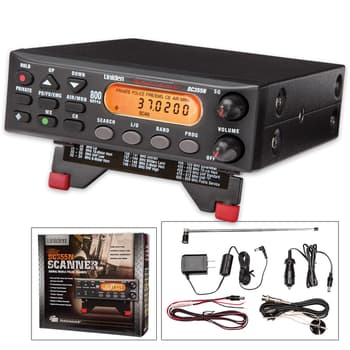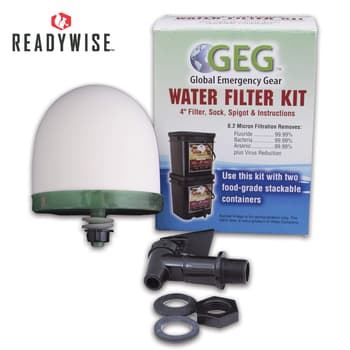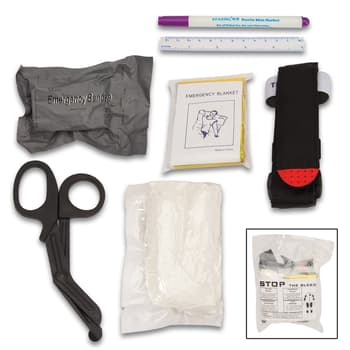The Cold War II Survival Tactics

By Adelia Ladson
Whether the sheeple want to believe it or are too fleeceable to realize it, we are in the middle of the Second Cold War, which in light of recent events, seems to be escalating. Make no mistake, we are at war! Although the nuclear option of the First Cold War is much less of a possibility than it was in the past, it is still lingering in the background. The most looming possibility, though, is a major cyber-attack that will disable our infrastructure. We’ve already seen our red enemies testing the water with hacking tactics and there is a very distinct possibility that the attacks will be ramped up. You need to be prepared for “consequences you have never seen in history.”
Have A Bug-Out Location
Since the best way for you and your family to survive in a war-time environment is to evacuate from populated areas, where there will most likely be conflict, you need to have a well-stocked bug-out location. It needs to be a place that you can get to quickly and be able to sustain your family permanently, if necessary. There also needs to be three or four different routes to get there in case of blocked roads, riots or traffic. Remember, you are trying to bug-out to a place that’s away from the madness caused by the panic of the sheeple.
There will be some financial investment required to set-up your bug-out location. People have as elaborate as a cabin or homestead to a camper or place in the woods to pitch a tent. A good suggestion that I found was to purchase a piece of land and then, gradually improve on it. Things to consider are: Is there a water source, is it far enough “off the beaten track”, is it defendable, is it camouflaged, and is the weather going to be an issue. What kind of shelter you have will depend on the yearly weather at your bug-out location. I wouldn’t plan on living in a tent in Colorado or Minnesota. Even milder climates down in the South can get a couple of days of freezing temperatures, so, you need to make sure that your shelter is equipped for that. It just depends on, realistically, how large of a financial investment you can make. If you are gradually improving on your bug-out location, that’s great but a cyber-attack won’t happen when it’s convenient for you. Provisions must be in place so that, if it happens tomorrow, you and your family have what you need to survive forever.
Stock Survival Supplies
Once you have your bug-out location secured, it needs to be stocked and ready with everything that you and your family needs to survive for the long-haul. You need to stock things like matches and candles, potable water and food staples so that you can maintain a somewhat normal existence. Those are just the basics because you also need to add medical and survival tools like a reliable emergency radio.
Food Prep
Since your food prep is really going to be the most entailed and the largest part of your overall prep, you need to start there. The easiest thing to start your food prep with is canned goods, which encompass everything from coffee to canned meats. They already have a sufficient shelf-life on an average of two to five years for most products. As long as they’re not rusted, bulging or punctured and the contents still smells okay once they’re opened, there is no reason why you shouldn’t be able to eat the food. Most canned foods do remain edible far past the expiration date stamped on the can. That being said, you still need to have a rotation plan because the taste, texture and nutritional value can degrade over time. Use a permanent marker to date all the canned foods that you buy and then, rotate them on a first-in-first-out basis. And speaking of canned goods, you also need to invest in some canned staples to stock your pantry with and I mean with things like butter and milk. If you’re wondering, at this point, how you’re going to keep these perishables, don’t worry, I got you covered. There’s some really great products out there including Future Essentials Powdered Butter and Ready Hour Powdered Whey Milk that have a 25-year shelf-life. Add to those staples white flour, which has a shelf-life of over five years as long as it’s kept dry and safe from pests like weevils. Although, salt is not a food, per se, it’s an essential staple to a well-balance diet. It can also be used in food preservation, and it has an indefinite shelf-life. You also need to stock dry goods like grains, beans, corn and pastas. Actually, a combination of beans, corn and rice provide almost everything you need to survive. They are the basics of a majority of the diets of countries around the world. Stock a variety of dried beans like pintos, black, chickpeas, lima and black-eyed peas. They all provide an excellent source of plant protein and endless meal recipes. Dry whole kernel corn has a lengthy shelf-life and will provide you with corn meal and all the foods that you can make with it like cornbread, corn cakes and tortillas, plus, it can be rehydrated to use in other recipes or as a side dish on its own. Extremely important to your psychological well-being during war is stocking a sufficient amount of comfort foods. These are going to be packaged foods like hot cocoa, cake, brownie and muffin mixes, boxed mac and cheese, boxed mashed potatoes and powdered juice drinks. Also include snacks like popcorn, sunflower seeds, hard candy and chewing gum. Another great comfort food product that no food prep is complete without is the Ready Hour Canned Peanut Butter Powder. The powder mixes into a creamy peanut butter spread that gives you 65 servings of a nutritious, tasty, nutty delight that can top your favorite bread or eat with fruit as a snack. In addition to your food prep, you need to also stock a sufficient number of mineral supplements and a good multi-vitamin, just to make sure that you’re getting the needed daily vitamins and minerals to stay healthy.
Shop Products Here:
- Future Essentials Powdered Butter
- Ready Hour Powdered Whey Milk
- Ready Hour Canned Peanut Butter Powder
Potable Water
One of the first things you have to consider during the prep of your bug-out-location is making sure that you have safe drinking water for you and your family. You need to make sure that you have a clean, reliable source of water like a well or either, a way to make the water, on-hand (lake or river), safe to consume. I suggest the Rothco Military Water Purification Powder because it will eliminate most bacteria and other harmful micro-organisms that may be found in water. You can also purify water with common, house-hold bleach, which should be a part of your prep, as well. One of the key ingredients to survival is cleanliness because, as history has proven, dirt breeds disease. You need an effective way to disinfect your living environment and absolutely nothing kills germs like bleach. IF you have a source, where you can get a lot of water at one time, you should get the Membrane Solutions Three-Liter Gravity Water Filter Bag and Straw, which has a three-stage filtration system. No batteries necessary, folks. Just hang it up in your shelter’s kitchen. Lastly, don’t forget to have a couple of five-gallon water containers to store the water once it’s purified.
Shop Products Here:
- Rothco Military Water Purification Powder
- Membrane Solutions Three-Liter Gravity Water Filter Bag and Straw
Alternate Light Source
You need to include an alternate lighting system in your prep because you don’t want to be without the comfort and safety of light at night. You have a few options when it comes to having a light source without electricity including battery-powered, solar-powered or just good old fire. You should have more than one lighting system in place because you need to be prepared for the long-haul. Days of cloudy weather aren’t good for solar power and batteries won’t last forever, even though you stock up on them. Eventually, you’ll be left with what our ancestors used – candlelight and firelight. Personally, I want to ease into that time and have artificial light as long as possible, so, let’s start with the battery-operated and solar-powered super bright LED systems first. The collapsible Trailblazer Pack-Away Camping Lantern is a great little battery-operated light. It’s so compact and portable that it will fit anywhere, making it great for your bug-out bag, too. It’s twice as bright as many LED lanterns of twice the size with 360-degrees of intense 250-lumen light that’s more than enough to flood a room with bright light. The Trailblazer Tri-Folding Solar Camping Light can be used in your rooms during the day and you can use your battery-operated lanterns at night. This combination helps save your batteries. It’s a propeller-shaped light designed to completely conform to your needs and each of the three 18-LED light panels can be adjusted independently to direct the light towards a specific direction. Moving to the flame-powered lights, the first one I want to mention is the Rayo Emergency Lantern Heater Cooker. It uses kerosene or lamp oil so that’s something you’ll need to stock-up on. It’s brighter and more efficient with advanced pre-heated air flow and a 12” extra-tall, heat-resisting chimney, while the adjustable, 2” flame is bright enough to light a small room and it lasts all night. Just a basic, classic system which I have in place, are my UCO Nine-Hour Candles. These candles will each provide you with nine hours of light and that’s incredible longevity for a candle. As with the other systems, you need to set up at least one in every room or what will provide you ample light for those long winter nights.
Shop Products Here:
- Trailblazer Pack-Away Camping Lantern
- Trailblazer Tri-Folding Solar Camping Light
- Rayo Emergency Lantern Heater Cooker
- UCO Nine-Hour Candles
Medical Supplies
A medical emergency can happen at any time, even if you’re hunkered down at home. You need to have the first aid gear and tools that are necessary to provide medical aid to a loved one, since professional medical care may not be a possibility. Basic medical supplies are absolutely necessary to prepping your bug-out location. One of the first things that you need to have as a part of your medical supplies prep is an all-inclusive, quality first aid kit. The Elite Tactical Trauma Kit is one of the best and most complete kits that you’ll find out there. The backpack contains more than 230 first aid supplies that can address both life-threatening and non-life-threatening situations. The Reusable Splint Set has different sizes of splints so that you are ready for any medical situation that requires a limb to be immobilized. When you’re looking to beef up your existing first aid kit, a smart choice is the Elite Stainless Steel Surgical Set. Especially, when you consider that a medical emergency requiring more than some antiseptic and an adhesive bandage needs to be prepared for in case a time comes where a doctor or hospital is no longer an option.
Shop Products Here:
Survival Tools
To complete your prepping for your bug-out location, there are a few specific survival tools that you need to add. These are tools that you will use to assist you in facing the new reality of a wartime environment. This is the be-all, end-all of what you need to add to your prep but just a few essentials that you need to have. The first thing that you need is a radio to keep you in tune with the weather conditions and to update you on what’s going on in the world around you. The one radio that all of our staff agree on is the Kaito Voyager Classic Solar Radio. Not only does it have seven pre-programmed NOAA weather stations, but it’s packed with functions like a NOAA alert, built-in wide-range speaker, AM/FM reception, an LED light and it will charge electronic devices through its USB port. Paracord is one of the most versatile survival tools that you can have. A good, seven-strand cord can be used from its inside strands to its outer casing, giving you endless options. Aside from the obvious, electrical tape also has tons of uses and is something you shouldn’t forget to add to your prep. Since it has excellent insulation properties, you can use it to insulate other things and its resilience can provide durability to whatever it’s wrapped around, as well. You need to have, at the very least, a wool blanket for every member of your family. Wool is the only natural fiber which retains its insulating abilities even while wet, keeping you warm and dry, whatever situation, you find yourself or your family in. Activated charcoal definitely needs to be added to your prep and it can be bought in bulk instead of supplement form. Its variety of uses include water filtration, emergency poison treatment, antidiarrheal, odor and moisture absorbent and an antibacterial for wounds. This may seem like a no-brainer, but you’d be surprised how many homes don’t actually have one. A knife sharpener is very important because you can’t survive a war without having knives that are going to stay sharp and usable. I suggest the Ridge Runner Knife Sharpener because it’s designed to keep a sharp edge on both single and double edged knives. Believe it or not, a large stock pot is an extremely valuable prep item. Of course, cooking family meals is the obvious use but it’s also a great tool when you need to purify large quantities of water. A stock pot can also be used to wash clothes in, if necessary, or collect rain water for drinking and gather food in when foraging. Finally, investing in a good, quality portable gas or diesel-powered generator will keep you, temporarily, in electricity. It can provide power to cooking appliances like table-top stoves and crockpots, mini refrigerators and space heaters.
Shop Products Here:
Learn Primitive Survival Skills
Being prepared, though, doesn’t stop at collecting supplies, it encompasses acquiring knowledge and learning skills, too. Skills will hold you in good stead when your supplies run out or low or are destroyed somehow. Being able to perform some primitive skills is important for survival. Primitive skills are what the human race was built on and if it all falls apart, they will be needed again. One of the most important primitive skills you should know is how to make fire because you could be in a situation where you don’t have the conventional means like a lighter or matches. All bets are off in a wartime environment and even your best laid plans could go awry when trying to get to the safety of your bug-out location. Trapping is another good skill to add to your cache of knowledge because, eventually, your canned or dried meat supplies will run out, along with your ammunition for hunting. You’ll need to save some of your ammo for self and home-defense. Snares are probably the simplest trap to make and require only thin wire or cord. The basic concept is that the animal is caught in a noose that you set-up along an animal trail or around a watering hole. Also, look into learning about foraging for edible plants and herbs. I suggest the Foraging For Wild Foods book as a great source to get started with.
Shop Products Here:
Be Ready To Roll
Since an attack can happen at any time, you need to be ready-to-go! Your vehicle always needs to be gassed-up and in top condition. This means, don’t get into a habit putting off getting gas until your tank is practically empty, have your vehicle serviced regularly and make sure that all maintenance is up-to-date. If you take care of your vehicle, it will take care of you when you need it most. Like I said above, you need to have some alternative routes in mind to your bug-out location just in case some routes are blocked or go through an area of conflict that needs to be avoided. Also, each member of your family needs to have bug-out bag packed and ready to grab. You can find out all you need to know about bug-out bags, in my What’s In A Bug-Out Bag? blog.
Stay Healthy And Fit
One of the most important things that you can do in preparation for a war is to make sure that you’re healthy and fit. Day-to-day living and survival will be much more challenging at your bug-out location. Getting back to basics and living like your forebears is a much harder life than you’re used to. You and your family need to be physically prepared for it. Look into military-style physical fitness regimens and incorporate them into your family’s activity schedule. When planning family outings opt for hiking and camping trips instead of movie and beach trips. Also make sure that your family’s diet is conducive to living a healthy life-style.



